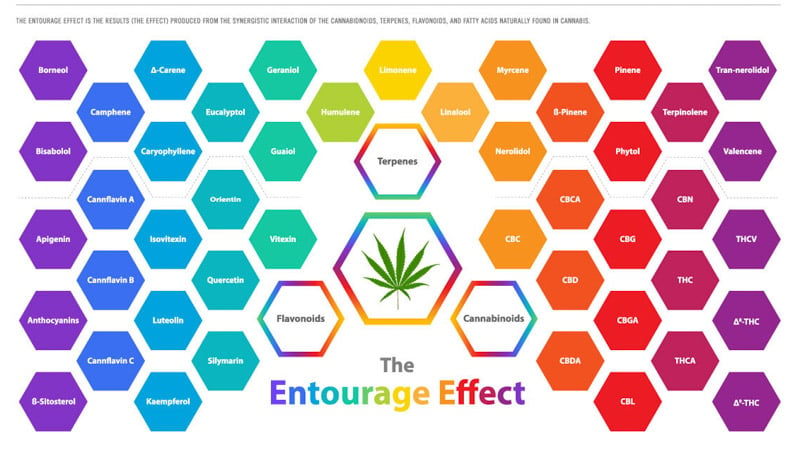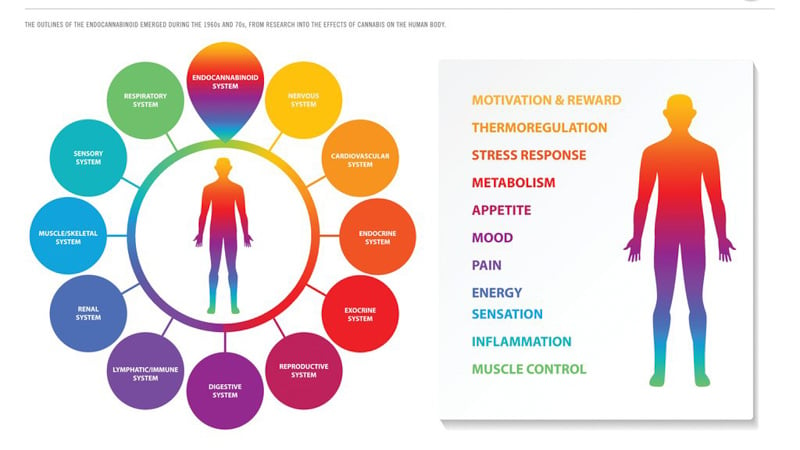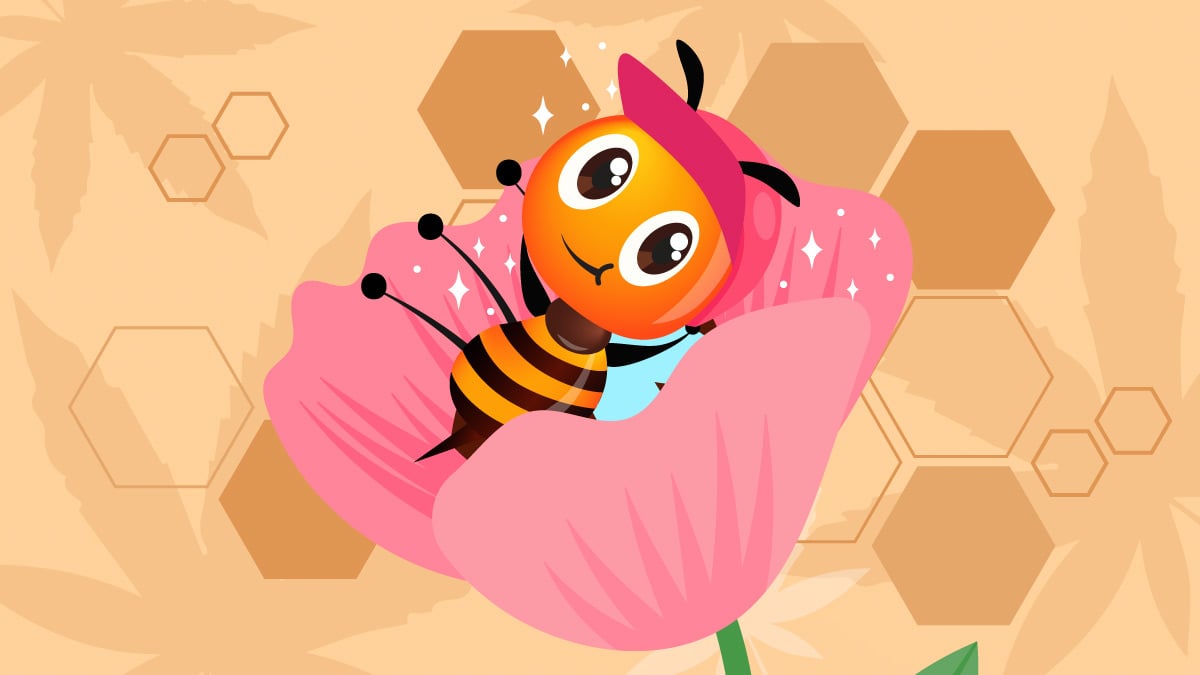The entourage effect is one of the most intriguing discoveries in recent times when it comes to cannabis plants and their compounds. Proponents of the entourage effect claim that extracts produced from the whole cannabis plant increase the efficacy of its health benefits — something that would be unachievable with isolated compounds.
Scientists have contradictory views on this concept. There are clear indications that full-spectrum cannabis extracts are more effective in certain cases than their isolated counterparts. The advocates of isolating specific compounds and standardizing dosages aren’t so positive about these findings, claiming that attributing the entourage effect to all situations is a far-reaching generalization.
A full-spectrum product in the world of cannabis includes cannabinoids — even traces of THC — terpenes, and other compounds. There are also broad-spectrum extracts and isolates. The broad-spectrum is like a “light” version of full-spectrum because it contains all the aforementioned substances except for THC. Isolates, in turn, refers to pure cannabinoids that have been separated from the remaining constituents of cannabis. These are flavorless and odorless products that are sold in powders or infused into different items.
In this article, we’ll focus specifically on the entourage effect; this will be the most detailed yet to-the-point guide you’ll ever read, so even when you’re done with the text, save it for later and share it with friends to increase their awareness about different CBD spectra.
What Makes Cannabinoids and Terpenes So Special?
Cannabinoids and terpenes are the active ingredients of cannabis that work synergistically to amplify the health benefits of each other. Cannabis researchers call it “the entourage effect.”
The debate has usually revolved around THC vs CBD, and comparing which one is better. But in fact, we should look at them as complementary compounds that can help you get the most out of your cannabis use.
Believe it or not, there’s a whole lot going on in the plant on a molecular level.
But how does one decode the term “entourage effect?” What is the role of the other 113 cannabinoids and 200 terpenes?
Find your answers in the next section.
What is the Entourage Effect in CBD?

In very simple terms, the entourage effect helps maximize the health benefits of CBD oil. It occurs when all the compounds within the cannabis plant interact with our bodies, producing stronger effects than they would if a person took them in isolation. These stronger effects are referred to as a “synergy.”
The entourage effect was first mentioned by two scientists in 1998 — Raphael Mechoulam and Shimon Ben-Shabat. They suggested that the endocannabinoid system (ECS) manifested “the entourage effect.” (1) According to the authors of the study, various “inactive” compounds and related molecules enhanced the activity of the major endogenous cannabinoids: 2-AG and anandamide. Mechoulam and Ben-Shabat said their discovery made it clear why botanical medications were often more effective than synthetic isolates.
For CBD oil users, it means that CBD isn’t the only compound responsible for the health benefits you experience. If you feel stronger relief from the stress of physical discomfort using a full-spectrum CBD oil, this may be caused by the synergistic effects provided by other cannabinoids, such as CBD, CBDV, CBG, CBC, or CBN, and terpenes such as beta-caryophyllene, limonene, myrcene, or linalool.
While CBD is a powerful compound on its own, it needs a team of supporters to develop its full potential.
Terpenes are fascinating molecules, and we’re going to devote an entire section to them, but before we make it there, let’s take a look at the most well-known entourage effect between CBD and THC.
THC & CBD: The Most Well-Known Cannabis Entourage Effect
One of the first observed and most cited entourage effects is the relationship between CBD and THC.
While THC, the cannabinoid that gets you high, binds directly to the CB1 cannabinoid receptors in the brain, CBD uses different mechanisms to manifest its effects. When you take these two compounds together, CBD reduces THC’s psychotic potential by blocking the sites of the CB1 receptors to which THC tries to bind. As a result, you feel less high than you would if you consumed THC alone.
The evidence supporting CBD’s ability to help take the edge off THC is piling up. In the 1980s, the Food and Drug Administration (FDA), approved a synthetic form of THC known as Marinol. While the medication did a decent job of increasing patients’ appetite, it also had side effects such as paranoia. Another FDA-approved drug, Sativex, contains both CBD and THC in a 1:1 ratio, so patients can tolerate it without getting too stoned.
Once you understand the interaction between CBD, THC, and the CB1 receptor, you should get a general idea of how the entourage effect works.
THC is the agonist of this receptor, meaning it works like a key that unlocks the receptor’s lock. CBD isn’t a direct agonist of the CB1 receptor, but it competes with THC for its space. As mentioned, taking these two compounds together leaves fewer receptors for THC to activate. In this scenario, the potential side-effects of THC, such as anxiety and paranoia, are modulated.
Adie Wilson-Poe, a professor at Washington University (St. Louis) says that CBD uses a minimum of 14 different mechanisms of action in the central nervous system alone. Aside from that, it has over 65 molecular targets. CBD acts through a myriad of pathways, so it’s hard to link its health benefits solely to CB1 occupation.
Now, when you take full-spectrum CBD oil, there are a lot more compounds entering your body. Using full-spectrum products activates legions of beneficial molecules at the same time.
Benefits of THC-Only Products
Please note that we cannot make any health claims regarding cannabis compounds. We always encourage you to do your own research and explore the world of cannabinoids and terpenes. Below we only share information about the potential benefits of THC-only and CBD-only products.fg
The benefits of THC include:
- Deep relaxation
- Relief from stress
- Reduced discomfort and stiffness
- Regulation of the sleep cycle
- Modulation of the gut microbiome
- Improved appetite
THC effects usually reach their peak when you consume an edible. When you eat a cannabis brownie, for example, THC gets metabolized in the liver, transforming into 11-hydroxy-THC. This metabolite is five times stronger than THC. So, when you smoke cannabis and take 10 mg of THC, it enters your lungs and goes to the bloodstream through the lung tissue. A 10 mg THC edible translates to 50 mg of THC when it comes to its potency.
Benefits of CBD-Only Products
CBD has very different effects from THC. The most vivid example is the lack of intoxication. It is the compound of choice for those who don’t tolerate THC well or are afraid of failing a drug test. Cannabidiol is also great for general supplementation because it supports the proper functioning of the endocannabinoid system.
CBD is mostly used to relieve:
- Stress
- Sleep deprivation
- Psychosis
- Physical discomfort
- Tiredness
- Endocannabinoid deficiencies
CBD also has a strong affinity with the immune system, regulating communication between immune cells and improving its performance.
What Happens When You Start to Use Whole-Plant Products?
The modulation of the psychoactive effects of THC is a significant benefit of the entourage effect, but the whole-plant concept is about more than that. Full-spectrum products can improve the overall efficacy of cannabinoids. The main reason why this is a new discovery is the lack of research regarding the health benefits of cannabis due to its prohibition. The minor cannabinoids, as well as terpenes, have many positive effects of their own, but it’s difficult to gauge the efficacy of certain entourage effects with different ratios of these compounds.
From our perspective, it’s rather a matter of the entourage effect making everything better rather than isolates being less effective — as far as preliminary research shows.
Evidence of the Entourage Effect

There’s a lot of science to support the higher efficacy of full-spectrum CBD. In 2011, Ethan Russo, one of the most esteemed cannabis researchers, published an important study in the British Journal of Pharmacology (2). In the study, Russo wrote that cannabinoids and terpenes produce synergistic effects that translate to better therapeutic effects.
Russo also conducted a more recent study published in the journal Frontiers in Plant Science in 2019 (3). He reviewed multiple studies that investigated the case for the Entourage effect. Russo concluded that there is strong evidence to suggest that the phytochemical factory in cannabis is more beneficial for humans than isolates.
In contrast, a study by Santiago et al., published in Biorxiv in 2019, claimed that there is no such thing as the entourage effect (4). The authors of the study analyzed the responses of cells transfected with human cannabinoid receptors (CB1 and CB2) in the presence of THC and a few selected terpenes.
The authors found that the receptors were not altered by any of these compounds, whether they coexisted together or were used in separation. However, the authors also admitted limitations to their research. The main concern was the fact that the team only focused on a single CB1 and CB2 pathway.
What Are Terpenes?
Most people think about fragrances and flavors in herbs when they hear the word “terpenes.”
However, the research conducted over the last few years have shown that terpenes are potent therapeutic molecules. That’s because they are responsible for starting the entourage effect in the cannabis plant.
Terpenes are volatile aromatic substances that evaporate easily and provide plants, fruits, vegetables, and spices with their unique aromas. The more aromatic the plant, the more terpenes are in it.
If you’ve ever wondered why cannabis strains smell differently but still have some characteristics similar to other plants — the answer is “terpenes.”
So far, we know about 200 terpenes in cannabis, but only a few of them occur in concentrations large enough to be worth mentioning.
Terpenes can be broken down into three groups:
- Monoterpenes
- Diterpenes
- Sesquiterpenes
Whether a specific terpene falls into one of these categories depends on the number of repeating units of a 5 carbon molecule known as isoprene, the structural marker of all terpenes.
10 Most Commonly Found Terpenes in Cannabis
As mentioned earlier, only a few terpenes are found in amounts substantial enough to mention them in this text:
Here are the 10 most commonly found terpenes in the cannabis plant:
- Myrcene
- Linalool
- Pinene
- Limonene
- Beta-Caryophyllene
- Humulene
- Eucalyptol
- Delta-3-Carene
- Borneol
- Terpineol
Health Benefits of Terpenes
It is true that terpenes influence the aromas of plants, but there’s a growing body of evidence that they have a plethora of health benefits — especially when consumed along with cannabinoids such as CBD.
The list of potential health benefits of terpenes include:
- Reduced stress
- Appetite control
- Relief from physical discomfort
- Cognitive boost
- Better blood circulation
- Modulation of nausea and vomiting
- Protection of healthy cells
- Sedation
Needless to say, these effects are stronger when put together in a cannabis extract such as full-spectrum CBD oil.
Final Thoughts on the Entourage Effect
The entourage effect has garnered a lot of attention recently. If this concept is true for all cannabis extracts, it may change the way people use hemp and marijuana-based products forever. However, the existence of this phenomenon doesn’t necessarily mean that broad-spectrum CBD or CBD isolate is inferior to full-spectrum products. There are cases where the entourage effect isn’t the desired effect.
Nevertheless, the concept that cannabinoids and terpenes are more powerful together than on their own is an intriguing one. In an interesting video, Dr. Sean McAllister evaluates the effects of THC and CBD on tumor growth. He suggests that using the two cannabinoids on cancerous cells in the lab leads to faster death of malignant cells while protecting the healthy ones.
The real challenge faced by scientists is to find out how we can possibly leverage the entourage effect by manipulating the ratios of cannabinoids and terpenes. When we get a deeper understanding of this phenomenon, we could adjust different forms of CBD to specific needs. Now that’s what we call personalized science!
References:
- Ben-Shabat, S et al. “An entourage effect: inactive endogenous fatty acid glycerol esters enhance 2-arachidonoyl-glycerol cannabinoid activity.” European journal of pharmacology vol. 353,1 (1998): 23-31. doi:10.1016/s0014-2999(98)00392-6
- Russo, Ethan B. “Taming THC: potential cannabis synergy and phytocannabinoid-terpenoid entourage effects.” British journal of pharmacology vol. 163,7 (2011): 1344-64. doi:10.1111/j.1476-5381.2011.01238.x
- Russo, Ethan B. “The Case for the Entourage Effect and Conventional Breeding of Clinical Cannabis: No “Strain,” No Gain.” Frontiers in plant science vol. 9 1969. 9 Jan. 2019, doi:10.3389/fpls.2018.01969
- Santiago, Marina et al. “Absence of Entourage: Terpenoids Commonly Found in Cannabis sativa Do Not Modulate the Functional Activity of Δ9-THC at Human CB1and CB2 Receptors.” Cannabis and cannabinoid research vol. 4,3 165-176. 23 Sep. 2019, doi:10.1089/can.2019.0016
